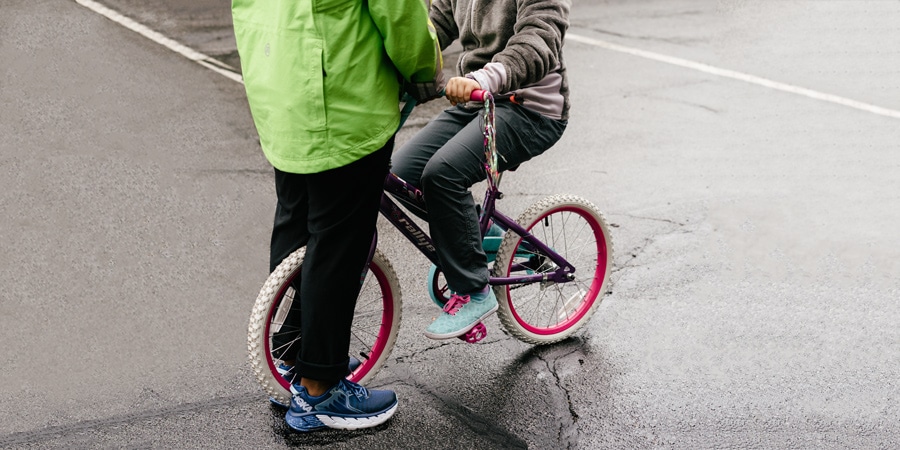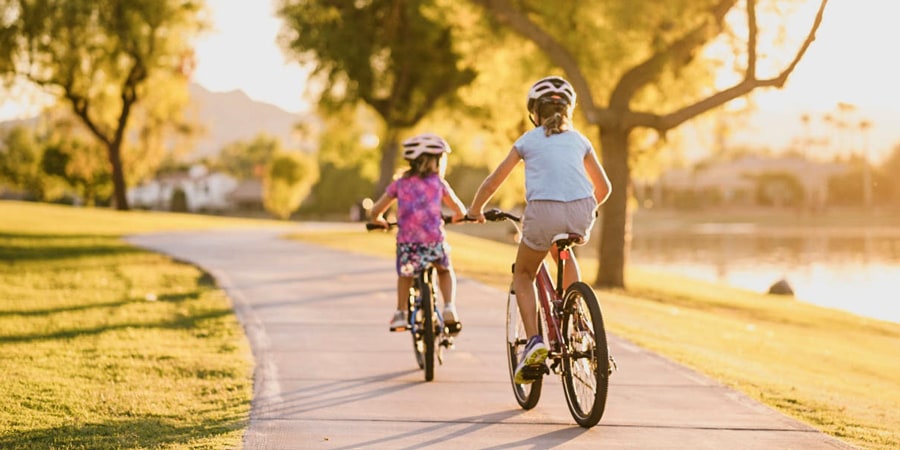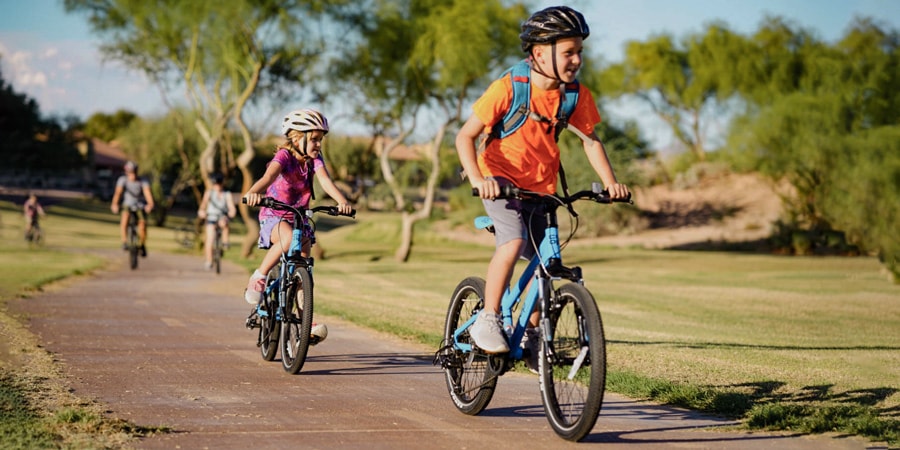From balance bikes for the smallest riders to youth mountain bikes with front suspension, there are a lot of two-wheel options available to young cyclists. But with so many choices, how do you narrow your search? We’ll guide you through the process of finding the right bike for your child.
The best indication of which size is right for your child is how comfortable they feel on the bike.
To get the right fit, it’s always best to have the child try several bikes out in person. That way they can sit on the seat, grip the handlebars, test the brakes and take the bike for a spin to make sure it fits and they can pedal comfortably. A skilled bike tech or sales associate at The Bike Garage store can help you with personalized fit recommendations.
If you’re not able to size a bike in person, it’s still possible (though a bit harder) to find one online by taking a child’s measurements and comparing them to bike specifications.
What Size Bike Does My Child Need?

The first thing to know when looking for kids’ bikes is that, unlike adult bikes, they’re measured by the size of the wheel rather than the frame. The most common kids’ bikes start at 12” wheels and run through 24” wheels. After that, bigger kids can choose from adult-sized bikes, which start at 26” wheels.
However, wheel size is just one starting point to consider as you look for a kids' bike. The following chart is offered as a rough guide and shouldn’t be a substitute for trying the bike out in person. Estimated age ranges are given here but keep in mind that age isn’t a major determining factor when sizing a bike for a child because of the differences in kids’ height, torso and legs within an age bracket. A bike that may fit one 7-year-old may be too big for another 7-year-old with shorter legs. Also, bikes with the same-size wheels may also vary between bike manufacturers.
Guide to Kids’ Bike Sizing
| Bike Wheel | Child Height (in.) | Approx. Age | Inseam (inside leg length) |
|---|---|---|---|
| 12-inch | 30-39 | 2-4 | 12-17 |
| 14-inch | 37-44 | 3-5 | 16-20 |
| 16-inch | 39-48 | 5-8 | 18-22 |
| 20-inch | 42-52 | 6-10 | 21-25 |
| 24-inch | 50-58 | 8-12 | 24-28 |
| 26-inch | 56+ | 10+ |
It’s especially important to buy a bike that fits well now rather than one that is too large and that they can grow into. A properly sized bike will be easier for kids to handle, a lot safer and more fun to ride.
Once you have a rough idea of the wheel size you need, have the child try several bikes out.
What to look for when your child is trying a new bike:
- How tall is the child (or how long are their legs)? The stand-over height—the distance between the top tube and the ground—is an important factor in sizing a kids’ bike. The child should be able to straddle the bike with their feet flat on the floor so their crotch isn’t resting on the top tube of the bike. This is both for comfort and safety.
- Can they reach the handlebars? The child should be able to comfortably grip the handlebars without fully extending their arms. A slight bend in the elbows is ideal. They should also be able to steer easily and squeeze the hand brakes, which are introduced starting at 20” bikes.
- Seat height: Most kids’ bikes are designed so they ride in a more upright position. They should be able to sit comfortably and see their surroundings easily. Their legs should be slightly bent at the bottom of the pedal stroke.
Online bike shopping tips: If you’re shopping online, you can narrow your choices by measuring the child’s inseam (the length of the inside leg) to make sure there’s enough clearance above the bike’s stand-over height. Look for listed stand-over heights for specific bikes and compare that number to the child’s inseam. The inseam should be higher than the stand-over height so the child isn’t resting on the top tube. (For example, if the child’s inseam is 18,” they’ll want a bike no bigger than a 17” stand-over height.)
To measure the child’s inseam (or the inside leg length), gather a large hardcover book or notebook, tape measure and pencil.
- Have the child stand against a wall.
- Put the book (spine up) between the child’s legs.
- Use the pencil to mark where the spine of the book meets the wall. Measure from the mark to the floor. This is your inseam.
12-inch- and 14-inch-wheel Bicycles
Approximate range: ages 2 to 4 (depending on child’s height and leg length)
Bikes with 12-inch wheels and low seats are a great way for the smallest riders to experience the freedom and fun that come with two wheels. If they can put their feet down, it’s easy for kids to learn to balance and scoot. In this category, you have a choice between balance bikes, which don’t have pedals, and bikes with pedals, which may also have removable training wheels.
Balance bikes: These are bikes in their simplest form—no pedals, crank or chain, just wheels and a frame. As the child walks or scoots along on the balance bike, their feet act as their brakes. These bikes are typically lighter and easier to handle than tricycles or bikes with training wheels, so kids can travel surprisingly fast on them. Balance bikes help teach the youngest kids how to coordinate steering and balance. The better they get at it, the easier their transition to pedaling will be.
Bikes with pedals: Bikes with 12- and 14-inch wheels are available with pedals and training wheels that can be removed. Training wheels can give children the confidence boost need so they can start riding on their own. These are single-speed bicycles with rear coaster brakes (simply pedal backward to engage), though some models have an additional rear brake controlled by a hand lever. Really young kids may not have the strength to pedal, so you may want to wait until they’re bigger or start them off with a balance bike.
16-inch-wheel Bicycles
Approximate range: ages 5 to 8 (depending on child’s height and leg length)
Once kids have outgrown their first bike, a 16” bike is typically the next step. It’s often a child’s first pedal bike. These bikes typically have rear coaster brakes (you pedal backwards to stop), and they usually have only one speed. Most come with training wheels that can be removed. You can also opt for a cruiser bike, which you’d choose mostly for style at this level.
20-inch-wheel Bicycles
Approximate range: ages 6 to 10 (depending on child’s height and leg length)
Bike features start to open up when you’re looking at bikes with 20-inch wheels. With the exception of cruiser bikes (which have coaster brakes), you’ll find that these bikes have hand brakes and options for multiple gears.
Choose the gearing:
Geared: Gears on a bike help you ride more efficiently and can make going uphill easier. Choose bikes with gears if you want the child to learn how to use them early or you plan to ride in hilly areas. Learn more in a future article on Bike Gears, or stay tuned for in-store workshops.
Choose the style:
- Mountain bike: Kids' mountain bikes usually have wider, knobbier tires and may also feature front shocks, which are designed to soften the impact of rough terrain by compressing and rebounding, and can help with overall stability. They’re perfect for kids who want to hit the trails or ride rougher terrain. Some manufacturers offer fatter tires for those wanting to go off road.
- Hybrid-style bike: These are great for all-around riding. These bikes have narrower tires and are lighter weight than bikes with front shocks.
24-inch-wheel Bicycles
Approximate range: ages 8 to 12 (depending on child’s height and leg length)
When looking for 24” bikes, you’ll find options and features more similar to adult bikes. Consider not only the way the bike fits but also how the child plans to use it. Do they want to ride off road or around the city? Unless you’re buying a cruiser bike, you’ll be looking at bikes with gears and hand brakes. There are different gear options depending on the style of bike and generally better components are available.
Mountain bikes: Choose a mountain bike if the child plans to ride off road. Many more features are available in kids’ mountain bikes of this size, including front suspension, more gears and components such as hydraulic disc brakes.
Hybrid-style: These bikes are for riding around the neighborhood or city. They have narrower tires and no front shock absorbers. The biggest reason to choose the hybrid is that they’re lighter and easier to handle.
Other Bike Shopping Tips

- Test out the hand brakes. Make sure your child’s hands can operate them.
- Make adjustments over time. When a child is first learning, you’ll want the seat low enough so they can touch the ground with both feet to stop and catch themselves if they fall. As they get better, you'll want them to be more on their tiptoes so they can pedal more efficiently and it’s not hard on their knees.
- Accessorize. What kids' bike is complete without a helmet and other accessories?









Comments
Be the first to comment...